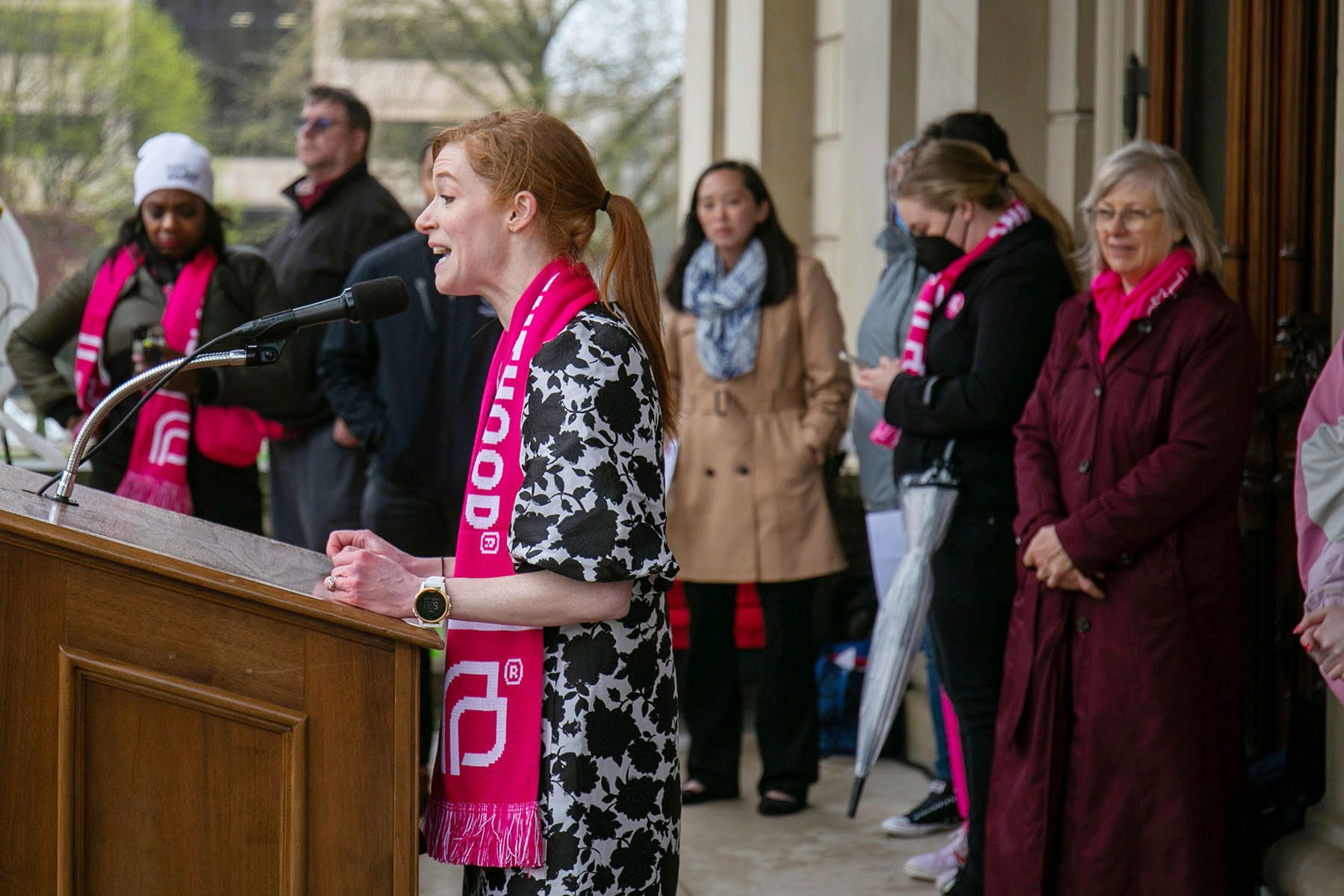We’re making sense of the midterms. Subscribe to our daily newsletter for election context and analysis.
Democrats defied significant headwinds on Tuesday to win races up and down the ballot, campaigning on abortion and reproductive freedom. But their gains were perhaps most significant — and surprising — in the state legislatures where they’ve been on defense for a decade.
Democrats are on track to win back dozens of seats nationwide and flip control of up to four legislative chambers in key Midwestern battleground states, results with significant implications for abortion access.
“We’re thrilled by these results,” Jessica Post, president of the Democratic Legislative Campaign Committee, told The 19th. “We think we’ll see a lot of progress in states like Michigan in terms of expansion and protection of abortion rights, collective bargaining, and progress overall.”
Here’s where things stand as of Thursday evening:
- Michigan: Democrats flipped control of both the state House and state Senate, creating a Democratic trifecta in the state government for the first time in 40 years come January. Michigan also passed a constitutional amendment enshrining the right to abortion in the state constitution.
- Minnesota: Democrats flipped control of the state Senate, establishing a Democratic trifecta in the state for the first time since 2014.
- Pennsylvania: Democrats have claimed victory, saying they flipped control of the state House, but several close races have not yet been called by the Associated Press. Pennsylvania also elected Democrat Josh Shapiro to the governor’s office.
- Democrats maintained their majorities in Colorado, Maine and New Mexico and won a supermajority in Vermont.
- Democrats also prevented Republicans from gaining veto-proof supermajorities in the state legislatures of North Carolina and Wisconsin, which have Democratic governors, reducing the chances of those states passing anti-abortion legislation.
“Make no mistake, this was a huge night for Democrats at the state legislative level,” Adam Pritzker, a founding partner of the States Project, which spent $60 million supporting Democrats in 2022 state legislative races, told reporters Thursday.
Democrats have been playing catch-up in state legislative chambers since the brutal “shellacking” of the 2010 midterms, as it was dubbed by then-President Barack Obama, and the partisan gerrymandering in statehouses that followed. In 2020, for example, Republicans flipped control of more than 80 state legislative seats nationwide despite President Joe Biden winning at the top of the ticket.
And 2022, a midterm year with an unpopular Democratic president in office and high inflation, initially looked like it would further Democratic erosion down-ballot. Research from Sister District, an organization dedicated to electing Democrats to state legislatures, finds the party in power has lost 8 to 26 percent of its battleground state legislative seats in midterms since 2004.
But 2022 also came on the heels of a highly unpopular Supreme Court decision overturning Roe v. Wade in June and the efforts by former President Donald Trump to overturn the 2020 election, which played out in state capitols around the country.
“I think some of the extremism in the Republican Party came home to roost,” Post said. She argued that in addition to being “really willing to embrace abortion,” state-level Democrats had a “much better story to tell” on economic and pocketbook issues, while Republicans were “out of focus.”
“They spent a lot of time in the legislatures attacking rights, promoting the Big Lie, and then picking on trans kids,” Post said of Republican lawmakers. “And so I think many of the voters said, ‘You’re not doing anything to address our day-to-day concerns.’”
Votes are still being counted, and the results of key statewide and state legislative races in states including Arizona and Nevada are still yet to be determined. But voters in key battleground states have penalized many candidates up and down the ballot who embraced unpopular positions on abortion and denied the outcome of the 2020 election.
“The results were delightful at the state level, but not shocking,” said Sister District co-founder Gaby Goldstein. “And I think that they really opened up an opportunity for Democrats and progressives to right the wrongs of generations past in underinvesting in state power — there’s a generational opportunity here.”
Carolyn Fiddler, a longtime state politics watcher and author of the newsletter This Week in Statehouse Action, argued that Republicans weren’t complacent either in spending or ground game, but failed to anticipate and properly message for the backlash coming their way on abortion.
“I think the Republican dog caught the car, and they weren’t prepared for the fallout,” she said. “They were not ready for the reality of a post-Roe electorate. Republicans at every level tried to convince everyone that this was not a big deal.”
The Republican State Leadership Committee, the main committee dedicated to electing Republicans to state offices, downplayed the significance of the fall of Roe. In a June polling memo, the committee argued that “while abortion is an issue people care about, the data makes clear that it is not among the top issues” motivating voters and charged that a “Democrat-corporate media joint campaign” was trying to make abortion a decisive issue.
That message “was obviously either a ginormous lie or mistake,” Fiddler said.
A confluence of several other factors, including redrawn maps in some states that were less likely to give Republicans an outsized number of seats based on their vote totals and a strong ground game, fed Democrats’ gains.
A new citizen-led commission in Michigan and commission-drawn maps in Pennsylvania gave Democrats a fighting chance in chambers once heavily gerrymandered to favor Republicans. Tens of millions in spending from groups including the DLCC, Forward Majority and the States Project, went toward supporting Democratic candidates.
“State legislative politics is not the minor leagues, it’s a different game entirely. And when we invest in these races in a real way and make these chambers the significant priority they are, we can win,” said Pritzker of the States Project.
Democrats also supercharged their field operations after the pandemic limited in-person canvassing in 2020.
“Democrats did a much, much better job this year of running actual credible field programs in these chambers that we were able to maintain and flip,” Goldstein said. “And I think in close races, that matters.”
Democrats now fully control 18 state governments, compared with 23 by Republicans, after flipping legislative chambers in Minnesota and Michigan and governorships in Massachusetts and Maryland.
Republicans this year did secure supermajorities in the Wisconsin and North Carolina state Senates and in the Florida legislature. But the loss of GOP-held chambers in Michigan and Minnesota are undeniable setbacks — especially considering the RSLC’s millions of dollars in investments in flipping Democratic-held chambers in states including Colorado, Maine, Oregon, New Mexico and Washington.
“While chamber battles are still playing out across the country, state Republicans defied the odds last night by facing down an onslaught of more than $130 million in national liberal spending and an incredibly challenging political environment,” Andrew Romeo, spokesman for the Republican State Leadership Committee, said in a statement.
“With minimal gains at the federal level, the Republican power we held and gained last night in the states will be all the more important for stopping Joe Biden’s disastrous agenda,” he added.
Alexis McGill Johnson, president and CEO of Planned Parenthood, said that Democrats’ victories in state legislatures weren’t a fluke, but came on the heels of years of organizing and investment led by groups like the DLCC. Abortion rights groups including Planned Parenthood, NARAL Pro-Choice, and Emily’s List, also invested in 2022 state-level and state legislative races.
“So many organizations have been working to get to this moment,” McGill Johnson said on a Wednesday call with reporters. “And we are now at a place where voters recognize the threat at the state level, and they are seeing how their states are taking action — and how their states are completely inconsistent with where the majority of their constituents are.”
Democrats reached a breakthrough in statehouses thanks to a successful strategy and fairer maps in some places. But they don’t have much time to rest on their laurels — the end of the 2022 midterms marks the beginning of even more contentious battles for statehouses and other key state offices in 2023 and 2024.
“Democrats did really well, and it highlights the artificial majorities Republicans have built for themselves in state legislatures,” Fiddler said. “It actually means if anything, it’s a little scarier for Democrats — this is going to scare Republicans and motivate Republicans even more.”
Beyond winning more seats, Goldstein says progressives should use their new power to pass progressive legislation and build lasting, durable political infrastructure rivaling the successful party-building in the states by conservatives.
“Otherwise, it’s just sandcastles. And that’s electoral politics, it’s just sandcastles unless you’re actually building something underneath that has a solid foundation, structurally and rhetorically,” she said. “This is the moment. The question is, will progressives who now care about state politics and state legislatures be able to harness this moment and bring it forward into sustained success?”






